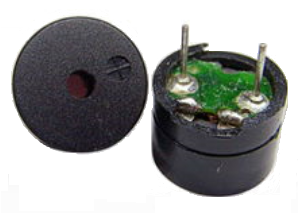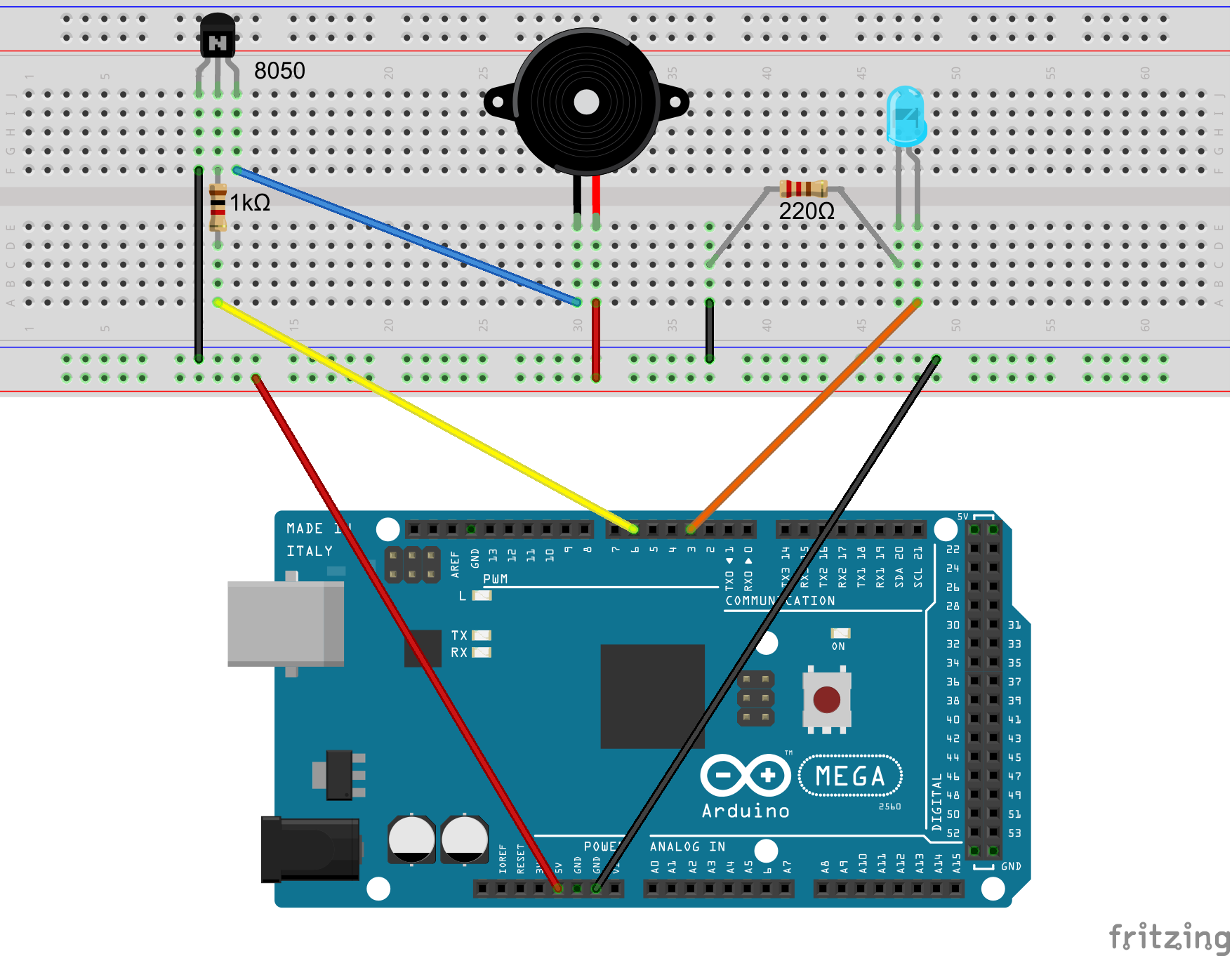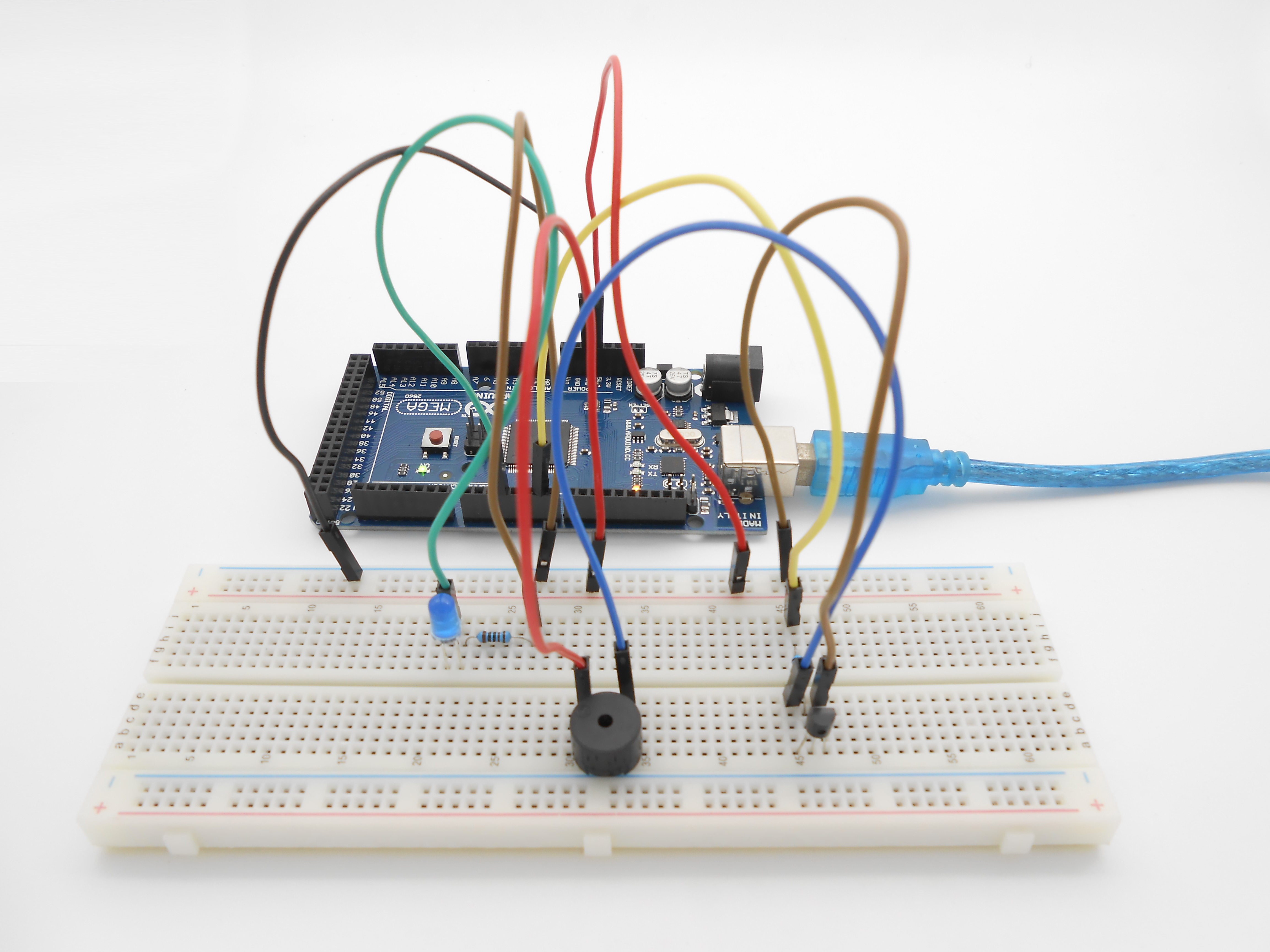Overview
In this lesson, we will program the Arduino to control a passive buzzer, and then make the passive buzzer play music.
Requirement
- 1* Arduino MEGA 2560
- 1* USB Cable
- 1* NPN Transistor (8050)
- 1* 1KΩ Resistor
- 1* Passive Buzzer
- 1* LED
- 1* 220Ω Resistor
- 1* Breadboard
- Several Jumper Wires
Principle
As long as you send the square wave signals to a passive buzzer with different frequency, then the passive buzzer will make different sound.

Key function:
●tone()
Generates a square wave of the specified frequency (and 50% duty cycle) on a pin. A duration can be specified, otherwise the wave continues until a call to noTone(). The pin can be connected to a piezo buzzer or other speaker to play tones.
Only one tone can be generated at a time. If a tone is already playing on a different pin, the call to tone() will have no effect. If the tone is playing on the same pin, the call will set its frequency.
Use of the tone() function will interfere with PWM output on pins 3 and 11 (on boards other than the Mega).
NOTE: if you want to play different pitches on multiple pins, you need to call noTone() on one pin before calling tone() on the next pin.
Syntax
tone(pin, frequency)
tone(pin, frequency, duration)
Parameters
pin: the pin on which to generate the tone
frequency: the frequency of the tone in hertz - unsigned int
duration: the duration of the tone in milliseconds (optional) - unsigned long
Returns
nothing
●noTone()
Stops the generation of a square wave triggered by tone(). Has no effect if no tone is being generated.
NOTE: if you want to play different pitches on multiple pins, you need to call noTone() on one pin before calling tone() on the next pin.
Syntax
noTone(pin)
Parameters
pin: the pin on which to stop generating the tone
Returns
nothing
Procedures
1. Build the circuit

2. Program
/***********************************************************
File name: 10_music.ino
Description: you can hear the passive buzzer playing music,
and you can see flickering LED follow the rhythm
of the music at the same time.
Website: www.adeept.com
E-mail: support@adeept.com
Author: Tom
Date: 2015/12/27
***********************************************************/
#define NTD0 -1 //bass 1# 2# 3# 4# 5# 6# 7#
#define NTD1 294 // A 221 248 278 294 330 371 416
#define NTD2 330 // B 248 278 294 330 371 416 467
#define NTD3 350 // C 131 147 165 175 196 221 248
#define NTD4 393 // D 147 165 175 196 221 248 278
#define NTD5 441 // E 165 175 196 221 248 278 312
#define NTD6 495 // F 175 196 221 234 262 294 330
#define NTD7 556 // G 196 221 234 262 294 330 371
#define NTDL1 147 //Alto 1 2 3 4 5 6 7
#define NTDL2 165 // A 441 495 556 589 661 742 833
#define NTDL3 175 // B 495 556 624 661 742 833 935
#define NTDL4 196 // C 262 294 330 350 393 441 495
#define NTDL5 221 // D 294 330 350 393 441 495 556
#define NTDL6 248 // E 330 350 393 441 495 556 624
#define NTDL7 278 // F 350 393 441 495 556 624 661
// G 393 441 495 556 624 661 742
#define NTDH1 589
#define NTDH2 661 //high pitch 1# 2# 3# 4# 5# 6# 7#
#define NTDH3 700 // A 882 990 1112 1178 1322 1484 1665
#define NTDH4 786 // B 990 1112 1178 1322 1484 1665 1869
#define NTDH5 882 // C 525 589 661 700 786 882 990
#define NTDH6 990 // D 589 661 700 786 882 990 1112
#define NTDH7 112 // E 661 700 786 882 990 1112 1248
//c pinlv // F 700 786 882 935 1049 1178 1322
#define WHOLE 1 // G 786 882 990 1049 1178 1322 1484
#define HALF 0.5
#define QUARTER 0.25
#define EIGHTH 0.25
#define SIXTEENTH 0.625
int tune[]= //Music tones
{
NTD3,NTD3,NTD4,NTD5,
NTD5,NTD4,NTD3,NTD2,
NTD1,NTD1,NTD2,NTD3,
NTD3,NTD2,NTD2,
NTD3,NTD3,NTD4,NTD5,
NTD5,NTD4,NTD3,NTD2,
NTD1,NTD1,NTD2,NTD3,
NTD2,NTD1,NTD1,
NTD2,NTD2,NTD3,NTD1,
NTD2,NTD3,NTD4,NTD3,NTD1,
NTD2,NTD3,NTD4,NTD3,NTD2,
NTD1,NTD2,NTDL5,NTD0,
NTD3,NTD3,NTD4,NTD5,
NTD5,NTD4,NTD3,NTD4,NTD2,
NTD1,NTD1,NTD2,NTD3,
NTD2,NTD1,NTD1
};
float durt[]= //Each musical tone delay time
{
1,1,1,1,
1,1,1,1,
1,1,1,1,
1+0.5,0.5,1+1,
1,1,1,1,
1,1,1,1,
1,1,1,1,
1+0.5,0.5,1+1,
1,1,1,1,
1,0.5,0.5,1,1,
1,0.5,0.5,1,1,
1,1,1,1,
1,1,1,1,
1,1,1,0.5,0.5,
1,1,1,1,
1+0.5,0.5,1+1,
};
int length;
int tonepin=6; //Buzzer connected digital pin 6
int ledp=3; //LED connected digital pin 3
void setup()
{
pinMode(tonepin,OUTPUT); //Digital pin 6 output mode
pinMode(ledp,OUTPUT); //Digital pin 3 output mode
length=sizeof(tune)/sizeof(tune[0]);//Calculate the total number of musical tones
}
void loop()
{
for(int x=0;x<length;x++)
{
tone(tonepin,tune[x]); //Open buzzer
digitalWrite(ledp, HIGH); //LED On
delay(400*durt[x]); //Tone Delay. Note:400 can be replaced
digitalWrite(ledp, LOW); //LED Off
delay(100*durt[x]); //Tone Delay. Note:100 can be replaced
noTone(tonepin); //Turn off the buzzer
}
delay(2000); //delay 2S
}3. Compile the program and upload to Arduino MEGA 2560 board
Now, you can hear the music of passive buzzer with blinking an LED.
